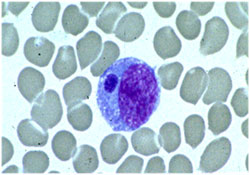Ehrlichiosis causes
|
Ehrlichiosis Microchapters |
|
Diagnosis |
|---|
|
Treatment |
|
Case Studies |
|
Ehrlichiosis causes On the Web |
|
American Roentgen Ray Society Images of Ehrlichiosis causes |
| Ehrlichiae | ||||||||||||||
|---|---|---|---|---|---|---|---|---|---|---|---|---|---|---|
 | ||||||||||||||
| Scientific classification | ||||||||||||||
|
Editor-In-Chief: C. Michael Gibson, M.S., M.D. [1] Associate Editor(s)-in-Chief: Ilan Dock, B.S.
Overview
Ehrlichiosis is a tickborne[1] bacterial infection,[2] caused by bacteria of the family Anaplasmataceae, genera Ehrlichia and Anaplasma. These obligate intracellular bacteria infect and kill the white blood cells. Ehrlichiae are transmitted to humans by the bite of an infected tick. Usually, symptoms occur within 1-2 weeks following a tick bite. [3]
Historical Perspective
Ehrlichiosis was first observed in the 19th century by the German microbiologist, Paul Ehrlich. Originally it was classified under the genus Rickettsia, however further observation led to a reclassification of the bacteria as a separate genus, Ehrlichia. The first Ehrlichia based infection was reported in South Africa in 1900. In the 1980's, Ehrlichiosis was recognized as a disease present in the United States. By 1999, Ehrlichia became a disease reportable to the Centers for Disease Control and Prevention. [4]
Taxonomy
| Classifications[5] [6] | |
|---|---|
| Domain | Bacteria |
| Kingdom | Prokaryote |
| Phylum | Proteobacteria |
| Class | Alpha Protobacteria |
| Order | Rickettsiales |
| Family | Anaplasmataceae |
| Genus | Ehrlichia |
| Species |
|
Phylogeny
- Small intracellular bacteria
- Infect vacuoles of host eukaryotic cells
- Gram-negative cell wall
- Grow within a host cells endosomes in morulae clusters
- Manipulate the endosomes mechanical function in order to resist lysosomal fusion
- Ehrlichiae exits the cell as morulae attaches to cell wall
- Target cells include neutrophils, platelets, erythrocytes, and endothelium
References
- ↑ CDC "Questions and Answers" page for tickborne rickettsial diseases
- ↑ Dawson, Jacqueline E., Marty, Aileen M. (1997). "Ehrlichiosis". In Horsburgh CR, Nelson AM. Pathology of emerging Infections. 1. American Society for Microbiology.
- ↑ CDC Ehrlichiosis main information page
- ↑ Reeves WK, Loftis AD, Nicholson WL, Czarkowski AG (2008). "The first report of human illness associated with the Panola Mountain Ehrlichia species: a case report". Journal of medical case reports. 2: 139. doi:10.1186/1752-1947-2-139. PMC 2396651. PMID 18447934.
- ↑ The Cause of Rocky Mountain Spotted Fever. Rickettsia Ricketsii. http://bioweb.uwlax.edu/bio203/s2008/gibson_chel/Classification.htm Accessed January 11, 2016.
- ↑ Dantas-Torres, Filipe. Lancet Infect Disease 2007;7:724-32. Department of Immunology, Center of Research Aggeu Magalhaes, Oswaldo Cruz Foundation. Recife Pernambuco, Brazil. Volume 7, November 2007. Accessed on January 11, 2016